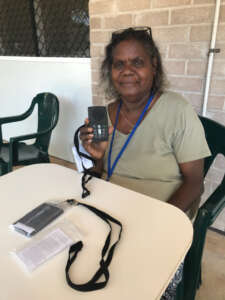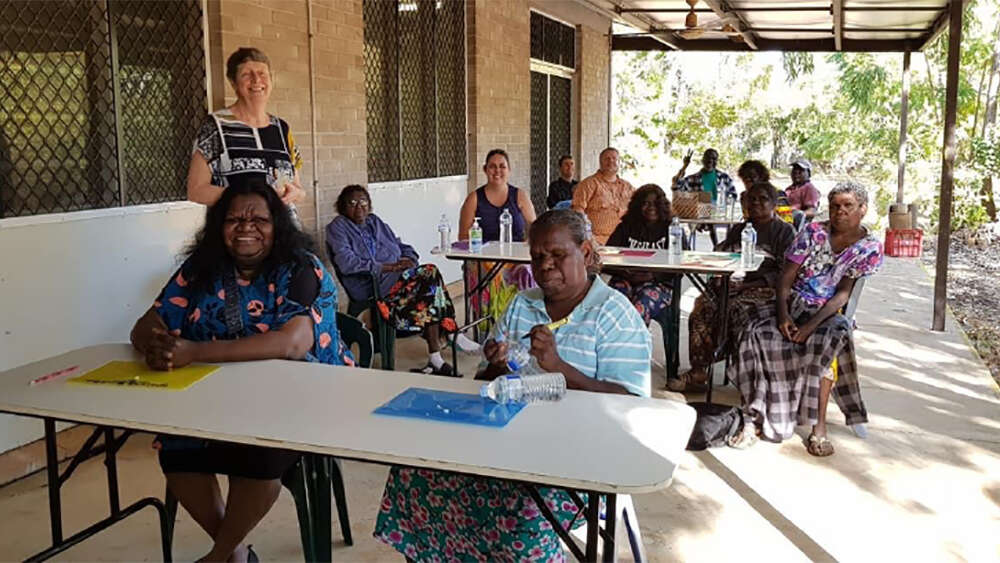Hearing is believing: audio Old Testament takes shape in Darwin
177 chapters of the Old Testament were captured in audio recordings in Australia’s ‘newest’ language spoken by First Nations people, in a three-week workshop in Darwin during August.
“Day One of the workshop was a thrill for me,” recalls the Bible Society’s Paul Kube. “I sat there behind my computer and sound desk, recording a speaker from the Roper Valley of Northern Territory, as they read out some chapters from the book of Leviticus in their Aboriginal Kriol language.
“It dawned on me, ‘hey, we’re making the Bible here.’ We weren’t translating the Bible; that’s already been done. The Kriol ‘Holi Baibul’ was completed in 2007. We weren’t prophesying the scripture, that happened thousands of years ago. But the process of bringing God’s Word to people who need to hear it is ongoing, and the project is going to make this possible for many people for the very first time.”
Hearing IS believing: translators from Bible Society, AuSIL (the Australian Society for Indigenous Languages) and Wycliffe Bible Translators – who partnered for the Darwin workshop – have come to believe that simply making the Bible available in printed form is not enough.
I’m convinced that we all need to get the story of the Bible inside of us.” – Paul Kube
“The dichotomy between ‘literacy’ and ‘orality’ can be a controversial one,” Kube tells Eternity. “Is making the Bible available in audio or oral formats undermining the work of translators who have painstakingly worked for 20-30 years to translate it? It’s important to value the precious and timeless work of Bible translation, but it also takes humility to realise that further steps must be taken.”
As Kube puts it, there is an informal rule in Bible translation of doing the New Testament first.
The Kriol audio Bible had already completed key parts of the Old Testament, so this time they recorded Leviticus (three chapters), Numbers (selected chapters), Joshua (about half), Judges (about half), 1 and 2 Kings (selected stories), 1 & 2 Samuel (selected stories), Job (selected chapters), Jeremiah (one third), Isaiah (one half), Ecclesiastes (selected chapters), Ezra and Nehemiah (selected chapters).
“Kriol speakers need the whole Bible, Kube adds. “There will still be a lot to do, even after this workshop.”

Wendy, holding a Megavoice player at the Kriol Workshop. Paul Kube, Bible Society
Kube’s job was recording the voices of people such as Wendy from Werenbun, who was one of the participants in the Kriol Old Testament audio recording project.
“Wendy and some other women from Arnhem Land came up to Darwin for two weeks. They gave passionately of their time. I sat down over a cup of tea one afternoon with Wendy and chatted about the project we had been working hard on. Wendy told me she has a love of the Old Testament stories, but that most people do not know them at all. She explained to me that many do not read well, and that others also have problems with eye sight.”
“Wendy was excited that making audio recordings would help so many of her people to hear these Old Testament stories for the first time.”
“I’m convinced that we all need to get the story of the Bible inside of us.
“It’s a big story, and we can really only begin to understand the depths of God’s love when we start to get the whole story inside us. Bible Society Australia is putting some rubber on the road to add to these recordings. We’re not simply making the digital recordings and then editing them, together with AuSIL, but we are also providing Megavoice audio players to listen to the recordings on.
“The Megavoice players are small, and yet they pack a punch in the volume they can put out. People can charge them with their phone chargers, or simply by turning the solar panel towards the sun. The players are durable, and can even be used in groups as people sit under a tree or by the campfire.”
“This has been done elsewhere in the world, but it’s groundbreaking in Australia.” – Paul Kube
Bible Society have provided 100 Megavoice players as a pilot project for the top end. The idea is to start with Kriol and branch out to other languages.
When it comes to the languages First Nations people speak, Kriol with 8,000 speakers heads the list, with a group of 3,000 people in southern ArnhemLland using it as their everyday language, according to Kube. He adds: “There is another group of ‘Kimberley Kriol’ speakers in WA. Yes, it’s part of the same language, but they consider the differences to be big enough that another project is being done in WA to translate the Bible using oral methods – not simply an audio reading.
“This has been done elsewhere in the world, but it’s groundbreaking in Australia.”
The existence of Kriol as a language, reflects the trauma of colonisation. It is descended from the “Port Jackson Pidgin” used by by cattle stockmen as they moved into the outback throughout the 1800s.
“In 1908 there was a war between cattle stockmen and indigenous peoples in the Roper Valley of Northern Territory. An Anglican Mission was established at Roper River in 1908 to take in and protect refugees from this war. That mission became the community that is today known as Ngukurr.”
At that Mission Station, there were people from eight different Aboriginal tribes: Mara, Warndarang, Alawa, Ngalakan, Ngandi, Mangarrayi, Rembarrgna and Nunggubuyu.
“The adults could speak multiple languages, but the children could not. The children of these eight tribes all communicated together in the descendant pidgin from Port Jackson pidgin, which was known by 1900 as ‘Northern Territory Pidgin English’.”
“As this was the only common language for these children, over time the pidgin went through a ‘creolisation” process, in which it gradually took on all the functions of a language.
“By the 1970s, Kriol was recognised in the NT as a separate language.”



